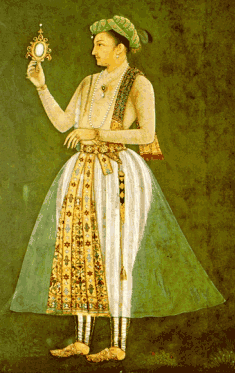|
|
|
Nuruddin
Jahangir (August 31, 1569 – October 28, 1627) was the
ruler of the Mughal Empire from 1605 until 1627. He signed a treaty
with the British East India Company promising their merchants
preferential treatment, opening the Indian subcontinent to Britain for
the first time.
He is also the person known to history as Shehzada Salim of Anarkali
fame, immortalized in the famous Urdu film Mughal-e-Azam. Prince
Selim's personal nickname was Shaikhoo. The name Jahangir is from
Persian جهانگير, meaning "Conqueror of the World", "World-Conqueror",
or "Dominant over the World". Alternative spellings of the name
include Jehangir, and Cihangir (in Turkish). |
 He was born as Prince Muhammad Salim in August 1569, the eldest son of
the Mughal Emperor Akbar. Akbar ensured that his son received the best
education possible. Salim started his studies at the age of four and
was taught Persian, Turkish, Arabic, Urdu, history, arithmetic,
geography and other sciences by important tutors like Abdur Rahim
Khan-i-Khahan. He was born as Prince Muhammad Salim in August 1569, the eldest son of
the Mughal Emperor Akbar. Akbar ensured that his son received the best
education possible. Salim started his studies at the age of four and
was taught Persian, Turkish, Arabic, Urdu, history, arithmetic,
geography and other sciences by important tutors like Abdur Rahim
Khan-i-Khahan.
Prince Salim succeeded to the throne on the eighth day after his
father's death. He took the name Jahangir and started his 22 years
reign at the age of 36. Having seized power, he had to fend off his
own son Prince Khusraw's claim to the throne. Khusraw was defeated and
as a punishment, his eyes were taken out.
Jahangir started his reign with several popular acts. He released
prisoners of war, promised to protect Islam and granted general
amnesty to his opponents. He set up a "Chain of Justice" outside his
palace. Anyone in trouble could simply pull the chain and receive a
hearing from the Emperor.
Jahangir married his twentieth and last wife, the extremely beautiful
and intelligent Mehr-un-Nisa, in May 1611. She was the widow of Sher
Afgan, one of Jahangir's lords, who died under questionable
circumstances. Mehr-un-Nisa was given the title of Nur Jehan on her
marriage to Jahangir.
Jahangir was fond of ease and comfort. He was an alcohol addict and
could be found day and night with wine goblets in his hands. He was
also susceptible to the influence of others, a weakness exploited by
many. Because of his inebriated state, Nur Jehan came to be the actual
power behind the throne.
He died in 1627 and was buried in Shahdra, a suburb of Lahore, Punjab,
Pakistan. His great mausoleum is still present and is a popular
tourist attraction.
He was succeeded by his son by Shah Jahan.
It was during Jahangir's reign that the British got formal permission
to trade freely in the Mughal Empire. This is often said to be his
greatest blunder for these traders went on to become the rulers of the
South Asia.
Jahangir was a good writer and loved nature. He recorded all sorts of
wildlife in his autobiography Tuzk-e-Jahangiri. He liked paintings and
collected many of them in his palace. Some of them are still found in
museums. |

